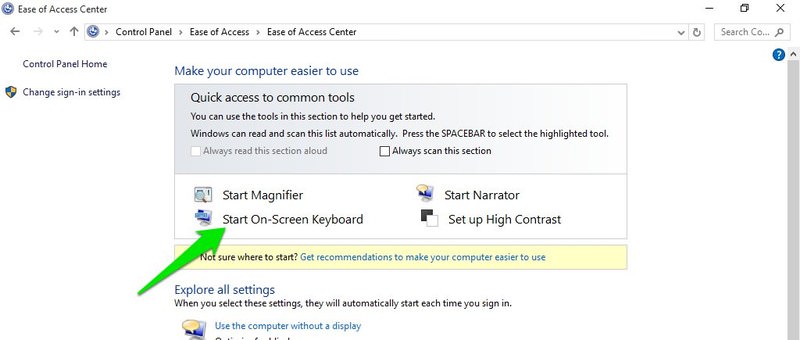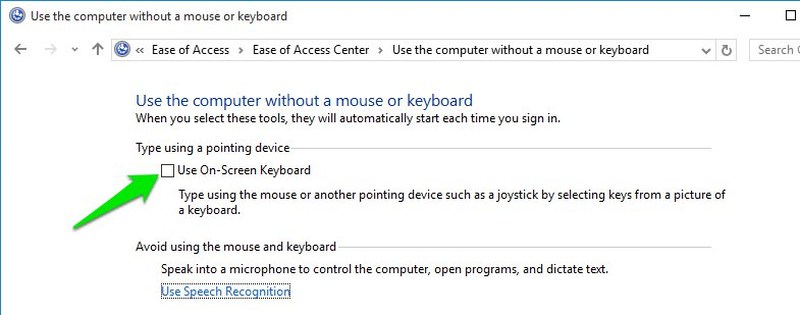How to Access Windows On-Screen Keyboard (OSK)
There’s a myriad of different physical keyboards for PCs available in the market. However, Windows also comes with a built-in virtual keyboard called the On-Screen Keyboard. This Ease of Access tool can be a lifesaver in many situations and knowing how to use it can surely help you in the hour of need.
The on-screen keyboard has all the standard keys of a physical keyboard that you can use with any computer mouse. So, for today’s post, I will show you multiple methods to access the on-screen keyboard in Windows 7 and Windows 10 along with some of its best uses. Let’s go through these points one-by-one.
Read Also: How to Control Windows Only With Keyboard
Access the on-screen keyboard in all versions of Windows
Following are some methods to access the on-screen keyboard that work in all the versions of Windows.
#1: From the Run dialog
- Press Windows + R keys ro open the Run dialog.
- Type
osk.exeor justoskand hit enter.
- The on-screen keyboard will open up.

The osk.exe command can also be used from the Windows command prompt if you prefer using the command prompt interface.
#2: From Ease of Access Center
You can easily start the on-screen keyboard through Windows Ease of Access Center. To open the Ease of Access Center, just press Windows + U keys and it will open up.
In case you don’t have the physical keyboard to press the shortcut keys, you can also go to Control Panel, click Ease of Access, from there select the Ease of Access Center, and finally click on the "Start On-Screen Keyboard" button to open up the on-screen keyboard.

#3: From the startup screen
The Ease of Access button is available on the startup screen (or log in screen) of all the versions of Windows.
Once you click on it, you’ll see a menu with multiple Ease of Access tools. Here select the option "turn on Windows on-screen keyboard" to launch it.
Access on-screen keyboard in Windows 7
Apart from the above options, you can also access the on-screen keyboard from the All Programs menu in Windows 7. Here’s how to do it:
- Click the Start menu, then select All Programs.

- Move to Accessories and then Ease of Access.
- Find and click On-Screen Keyboard to launch the virtual keyboard.

Access on-screen keyboard in Windows 10
In Windows 10 (as well as Windows 8) there are two types of virtual keyboards, the regular full keyboard and a touch keyboard for use on touch-based devices. Let’s see in the following how you can access both keyboards, respectively.
Access full on-screen keyboard
- Click the Start menu and select Settings.

- Next, click on the Ease of Access option.
- Move to the Keyboard section, toggle the option Turns on the On-Screen Keyboard, and the on-screen keyboard will show up.

Access touch keyboard
To access the touch keyboard, do the following:
- Right-click on the taskbar and make sure the “Show touch keyboard button” option is selected.
- With the option enabled, you should be able to see a keyboard icon in the taskbar system tray. Just click on it and the touch keyboard will launch.


Note: The touch keyboard is same as your smartphone’s touch keyboard and of course, you can only use it on touch-based devices.
Stop on-screen keyboard from starting up with Windows
Accessing the on-screen keyboard is easy, but the on-screen keyboard has a bad habit of forcing itself to start with Windows. Depending on which method you choose to access the on-screen keyboard there is a chance that it may force itself to start every time you log in to Windows.
I believe this behavior is there to help people who depend on the on-screen keyboard to easily access it. However, it can become nuisance when you don’t need it anymore.
To prevent the on-screen keyboard from starting up with Windows:
- Press Windows + U keys to open Ease of Access Center.
- Click “Use the computer without a mouse or keyboard”.
- Uncheck the checkbox next to “Use On-Screen Keyboard”.


On-Screen Keyboard Uses
Now let’s discuss the situations when the on-screen keyboard can prove useful, as well as some of its other benefits.
Limited resources
The most common reason why you need to use the on-screen keyboard is when you have limited resources. Such as:
- You don’t have a physical keyboard or it just stopped working.
- One or more keys on the keyboard are not working or are stuck.
- Keyboard drivers failed/corrupted and you need to use the on-screen keyboard to diagnose it.
- You have a temporary or permanent physical disability.
You are using a touch based device
If you are using a touch based device or have connected your PC’s display to a touch based device, then the on-screen keyboard will definitely be easier to use.
Your laptop doesn’t have numeric keypad
Many compact laptops don’t have a numeric keypad. If you have such a laptop and need to use the numeric keypad, then you can turn on the on-screen keyboard and use its numeric keypad.
Although, you will have to go to its options and enable it first. See the screenshot below.

To securely enter passwords
Keyloggers are a common malware type that track a user’s keystrokes on the keyboard to steal username and passwords. Fortunately, it is really hard for a malware to track your strokes on an on-screen keyboard.
If you doubt that a keylogger may affect your device, then you can use the on-screen keyboard to ensure security.
Enter emojis
The touch keyboard in Windows 8 and 10 has hundreds of built-in emojis, which of course a physical keyboard doesn’t have.
You can turn on the touch keyboard and click on the emoji icon to access and use the emojis.

Take advantage of the prediction feature
The on-screen keyboard in Windows 8 and 10 also has a prediction feature to predict text as you type. If you don’t like typing all the words, then the prediction feature will surely please you.
Easily change keyboard layout
You can easily change the layout of the on-screen keyboard and use it in your favorite language. Here is a handy article from Microsoft support to help you change your language and keyboard layout.
Some concluding thoughts
The on-screen keyboard is one of the most useful tools in Windows that can prove to be quite helpful in certain situations. It can be easily accessed using different methods, all of which have been mentioned above.
If you already use the on-screen keyboard, do tell us about your experience in the comments.
Read Also: Windows 7 Keyboard Shortcuts to Increase Productivity